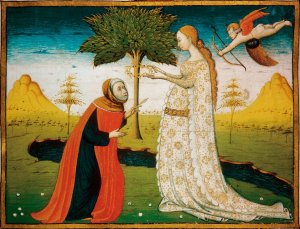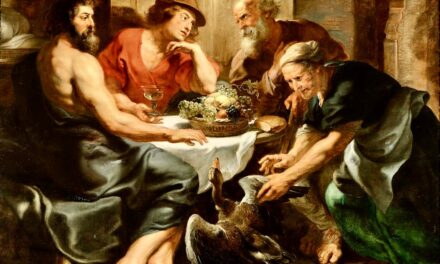We support our Publishers and Content Creators. You can view this story on their website by CLICKING HERE.
These six composers might not have been saints, but the splendor of their voices bears a living witness to the Lord. Well may we hope and pray that their songs may continue to be sung and that they may be heard more clearly amid the din and discord of our modern world.
Christianity has died many times and risen again,” wrote G.K. Chesterton, “for it had a God who knew the way out of the grave.” These words ring true of history in general and especially perhaps of recent history. At the beginning of the nineteenth century, dispassionate observers might have considered that Christianity had died or at least that it was terminally ill and dying. The previous century had seen absolutist monarchs subjecting religion to the power of the state and had ended with the French Revolution, the world’s first avowedly atheist and secular fundamentalist uprising against religion in general and Catholic Christianity in particular.
What was worse was the apparent impotence of the Church, which seemed unable to resist the ravages of nationalism, rationalism, and revolution. As the eighteenth century ended, a weak pope, Pius VI, died as an exile in France, the prisoner of Napoleon. All must have seemed lost.
And yet the nineteenth century was a time of great Catholic revival in Europe and the Americas; and nowhere was this more evident than in France itself. After the Revolution had torn itself apart in its own bloodlustful hatred and after Napoleon had met his literal Waterloo, the Church would rise from the ashes phoenix-like and from the grave Christ-like.
By the middle of the century, the Catholic revival in France found its voice culturally in music and the restoration of Gregorian chant. The greatest sacred work composed during this revival was Gabriel Fauré’s justly celebrated Requiem. His praises have been adequately sung, however, precluding his being considered an “unsung hero” of Christendom; nor was he a practicing Catholic.
Along with Debussy and Ravel, Fauré is probably the best-known of the French composers of the late-nineteenth and early-twentieth centuries. Yet several French composers of the twentieth century deserve to be better known. “While Fauré, Debussy, and Ravel had no meaningful connection with the Catholic Church,” writes Susan Treacy, author of The Music of Christendom, “these younger composers were, or became, fervent Catholics.” Six, in particular, deserve special attention as unsung heroes who are not as well-known as they should be.
Louis Vierne (1870-1937) suffered from near blindness, a disability which would inspire his vocation as a musician and composer. “The good Lord, who has taken my eyes, will surely help me,” he said of his decision to devote his life to music. He would serve as organist at the Cathedral of Notre-Dame in Paris for almost forty years and would compose six great organ symphonies, in addition to works for voice, orchestra, piano, and chamber ensembles.
His Messe Solennelle for choir and two organs was expressive of the great liturgical revival at the time. The majesty of this grandiose setting of the Mass was encapsulated by organist and music journalist David Gammie:
Following the awesome solemnity of the Kyrie and the triumphant Gloria and Sanctus, the mysterious antiphonal harmonies of the Benedictus sound a completely new note in the French church music of the time, and the long-breathed phrases of the Agnus Dei bring the whole work to a wonderfully serene conclusion.
Paul Paray (1886-1979) is the composer of three significant sacred works: his Pastorale de Noël (Christmas Pastoral); his magnificent oratorio, Jeanne d’Arc (Joan of Arc); and his Mass composed to commemorate the quincentenary of St. Joan of Arc’s martyrdom.
The Pastorale de Noël begins with the prophets who had foretold the coming of the Messiah and with the “desolate” souls in Limbo awaiting the coming of the One who will set them free. The Christmas narrative continues with the Annunciation, the arrival of Mary and Joseph in Bethlehem, the apparition of the angels to the shepherds, adoration of the newborn Babe in the manger, including a lullaby sung by the Blessed Virgin to her child, and concluding with the arrival of the Wise Men bearing their gifts.
Jeanne d’Arc sings to the glory of the Maid of Orleans in the retelling of the story of her martyrdom, ending with the promise that a “radiant angel” will guide her “white-winged soul” to Heaven.
In his later years, Paray came to America and was music director of the Detroit Symphony Orchestra from 1952 until 1963. He is still celebrated in the city because Fr. Eduard Perrone, pastor of Assumption Grotto Church, is a great champion of Paray’s music and has conducted recorded performances of the Pastorale de Noël and Jeanne d’Arc with the Assumption Grotto Choir and Orchestra.
Francis Poulenc (1899-1963) lived a miserably sinful life prior to his conversion but composed some wonderful sacred music following his embrace of the Faith. “I adore Poulenc’s music, both sacred and secular,” writes Susan Treacy,
but he has a controversial life. He was a practicing homosexual. However, in 1936 he had a major reconversion to his Catholic faith and returned to the sacraments (including Confession) after a dear friend was killed in a car crash. He then went on to compose some of the greatest sacred music of the century.
Perhaps Poulenc’s most celebrated sacred work is Dialogues des Carmélites (Dialogues of the Carmelites), an opera which premiered in 1957. Inspired by the novel of the same name by Georges Bernanos, published eight years earlier, it tells the true story of sixteen Carmelite nuns, the Martyrs of Compiègne, who were guillotined in 1794 during the Reign of Terror following the French Revolution and were canonized by St. Pius X in 1906.
Maurice Duruflé (1902-1986) was deeply influenced by the liturgical revival happening at the time of his musical formation in his childhood, as Susan Treacy explains:
Central to Maurice’s musical experience as a cathedral chorister was Gregorian chant. In 1903 Pope Saint Pius X had issued his motu proprio on sacred music (Tra Le Sollecitudini), in which Gregorian chant and sacred polyphony were promoted. By the time Maurice became a chorister at Rouen Cathedral, the Solesmes monks’ restoration of chant to its ancient purity had already been incorporated into the cathedral’s musical life.
Years later, as a composer, he incorporated chant into his own work, especially in his Requiem, composed in 1947. Duruflé was unhappy with the widespread abandonment of chant following the Second Vatican Council and might have composed his Messe “Cum Jubilo,” which is based on the Gregorian Mass IX, in defiance of the new and lamentable trend of adopting popular and modern secular musical styles into the liturgy at the time of its composition in 1966. “I absolutely love Duruflé’s music,” writes Susan Treacy, “and wish he had composed more. He was a devout Catholic, somewhat reclusive, and composed almost exclusively sacred music.”
The fifth French composer whose praises should be sung is another of the great French organist-composers of the twentieth century, many of whom were strong Catholics. Charles Tournemire (1870-1939) shared Duruflé’s love of Gregorian chant, incorporating it in many of his works.
His most celebrated work, L’Orgue Mystique, is described by Susan Treacy as “a kind of Liturgical Year for the Organ.” Inspired by Gregorian chant and by the music of Bach, L’Orgue Mystique also reflects the work of Dom Prosper Guéranger, the abbot of Solesmes from 1837 to 1875, whose multivolume L’Année Liturgique (The Liturgical Year) was a major influence on the Catholic revival of which Vierne, Paray, Poulenc, Duruflé, and Tournemire were such an important if largely unsung part.
The sixth and final composer is Olivier Messiaen (1908-1992), whose compositions are preoccupied with the theme of eternity. From his very early work Le Banquet Celeste (The Heavenly Banquet), dating from 1927, to later works, such as Quatuor pour la fin du temps (Quartet for the End of Time), which premiered in 1941, he sought to evangelize the dark and war-torn times in which he found himself with the timeless beauty of God’s presence in both time and eternity. This visionary mission was encapsulated by Susan Treacy:
In the increasingly secular twentieth century, Messiaen sought to reveal the sublimity, the vastness, the depths, the tenderness, the anguish, the joy, the clarity, and the mystery of Catholicism to a world that did not care to be reminded of its own finiteness and apostasy.
One way in which Messiaen sought to do this was through the evocation of the beauty of birdsong within his works. Seeing birds as “little servants of immaterial joy,” he considered them as akin to angels, as messengers of God’s presence in the beauty of song. If Messiaen is right, and he is, then he and the other six featured composers are themselves akin to angels, blessing the earth and the heavens with the beauty of their songs.
As Benedict XVI reminds us, “[t]he only really effective apologia for Christianity comes down to two arguments, namely the saints the Church has produced and the art which has grown in her womb.” It was, he added, the “splendor of holiness and art” which bore the best witness to the Lord.
These six composers might not have been saints, but the splendor of their voices bears a living witness to the Lord. Well may we hope and pray that their songs may continue to be sung and that they may be heard more clearly amid the din and discord of our modern world.
This essay is part of a series, Unsung Heroes of Christendom.
The Imaginative Conservative applies the principle of appreciation to the discussion of culture and politics—we approach dialogue with magnanimity rather than with mere civility. Will you help us remain a refreshing oasis in the increasingly contentious arena of modern discourse? Please consider donating now.
The featured image is Elin Rombo as Sister Blanche in Dialogues of the Carmelites in a 2011 production at the Royal Swedish Opera. This file is licensed under the Creative Commons Attribution 3.0 Unported license, courtesy of Wikimedia Commons.

 Conservative
Conservative  Search
Search Trending
Trending Current News
Current News 






